Fabrication of a Protective Hybrid Coating Composed of TiO2, MoO2, and SiO2 by Plasma Electrolytic Oxidation of Titanium
Abstract
:1. Introduction
2. Experimental Procedures
3. Results and Discussion
4. Conclusions
Author Contributions
Funding
Institutional Review Board Statement
Informed Consent Statement
Data Availability Statement
Conflicts of Interest
References
- Boyer, R.R. Titanium for aerospace: Rationale and applications. Adv. Perform. Mater. 1995, 2, 349–368. [Google Scholar] [CrossRef]
- Moskalewicz, T.; Warcaba, M.; Zimoski, S.; Lukaszcyk, A. Improvement of the Ti-6Al-4V Alloy’s tribological properties and electrochemical corrosion resistance by nanocomposite TiN/PEEK708 coatings. Metall. Mater. Trans. A 2019, 50, 5914–5924. [Google Scholar] [CrossRef] [Green Version]
- Li, Y.; Yang, C.; Zhao, H.; Qu, S.; Li, X.; Li, Y. New Developments of Ti-Based Alloys for Biomedical Applications. Materials 2014, 7, 1709–1800. [Google Scholar] [CrossRef] [Green Version]
- Bodunrin, M.O.; Chown, L.; van der Merwe, J.W.; Alaneme, K.K.; Oganbule, C.; Klenam, D.E.; Mphasha, N.P. Corrosion behavior of titanium alloys in acidic and saline media: Role of alloy design, passivation integrity, and electrolyte modification. Corros. Rev. 2020, 38, 25–47. [Google Scholar] [CrossRef]
- Prando, D.; Brenna, A.; Diamanti, M.V.; Beretta, S.; Bolzoni, F.M.; Ormellese, M.; Pedeferri, M. Corrosion of Titanium: Part 1: Aggressive Environments and Main Forms of Degradation. J. Appl. Biomater. Funct. Mater. 2017, 15, e291–e302. [Google Scholar] [CrossRef]
- Kaseem, M.; Fatimah, S.; Nashrah, N.; Ko, Y.G. Recent progress in surface modification of metals coated by plasma electrolytic oxidation: Principle, structure, and performance. Prog. Mater. Sci. 2021, 117, 100735. [Google Scholar] [CrossRef]
- Mashtalyar, D.; Nadaraia, K.; Sinebryukhov, S.; Gnedenkov, S. Polymer-Containing Layers Formed by PEO and Spray-Coating Method. Mater. Today Proc. 2019, 11, 150–154. [Google Scholar] [CrossRef]
- Mojsilović, K.; Božovića, N.; Stojanović, S.; Damjanović-Vasilić, L.; Serdechnova, M.; Blawert, C.; Zheludkevich, M.L.; Stojadinović, S.; Vasilić, R. Zeolite-containing photocatalysts immobilized on aluminum support by plasma electrolytic oxidation. Surf. Interfaces 2021, 26, 101307. [Google Scholar] [CrossRef]
- Podgorbunsky, A.B.; Nadaraia, K.V.; Imshinetsky, I.M.; Sinebryukhov, S.L.; Gnedenkov, S.V. Formation on magnesium alloy MA8 bioactive coatings containing nanosized hydroxyapatite. J. Phys. Conf. Ser. 2018, 1092, 012117. [Google Scholar] [CrossRef]
- Kaseem, M.; Choe, H.-C. Simultaneous improvement of corrosion resistance and bioactivity of a titanium alloy via wet and dry plasma treatments. J. Alloys Compd. 2021, 851, 156840. [Google Scholar] [CrossRef]
- Kaseem, M.; Choe, H.-C. Electrochemical and bioactive characteristics of the porous surface formed on Ti-xNb alloys via plasma electrolytic oxidation. Surf. Coating. Technol. 2019, 378, 125027. [Google Scholar] [CrossRef]
- Kaseem, M.; Choe, H.-C. Triggering the hydroxyapatite deposition on the surface of PEO-coated Ti–6Al–4V alloy via the dual incorporation of Zn and Mg ions. J. Alloys Compd. 2020, 819, 153038. [Google Scholar] [CrossRef]
- Kaseem, M.; Hussain, T.; Zeeshan, U.; Yang, H.; Dikici, B.; Ko, Y. Fabrication of functionalized coating with a unique flowery-flake structure for an effective corrosion performance and catalytic degradation. Chem. Eng. J. 2021, 420, 129737. [Google Scholar] [CrossRef]
- Nellaiappan, A.; Ashfaq, M.; Krishna, L.R.; Rameshbabu, N. Fabrication of corrosion-resistant Al2O3–CeO2 composite coating on AA7075 via plasma electrolytic oxidation coupled with electrophoretic deposition. Ceram. Int. 2016, 42, 5897–5905. [Google Scholar] [CrossRef]
- Kaseem, M.; Lee, Y.H.; Ko, Y.G. Incorporation of MoO2 and ZrO2 particles into the oxide film formed on 7075 Al alloy via micro-arc oxidation. Mater. Lett. 2016, 182, 260–263. [Google Scholar] [CrossRef]
- Gnedenkov, S.V.; Sinebryukhov, S.L.; Mashtalyar, D.V.; Imshinetskiy, I.M.; Samokhin, A.V.; Tsekov, Y.V. Fabrication of coatings on the surface of Magnesium alloy by plasma electrolytic oxidation using ZrO2 and SiO2 naoparticles. J. Nanomater. 2015, 2015, 154298. [Google Scholar] [CrossRef] [Green Version]
- Gowtham, S.; Hariprasad, S.; Arunnellaiappan, T.; Rameshbabu, N. An investigation on ZrO2 nano-particle incorporation, surface properties and electrochemical corrosion behaviour of PEO coating formed on Cp-Ti. Surf. Coat. Technol. 2017, 313, 263–273. [Google Scholar]
- Di, S.; Guo, Y.; Lv, H.; Yu, J.; Li, Z. Microstructure and properties of rare earth CeO2-doped TiO2 nanostructured composite coatings through micro-arc oxidation. Ceram. Int. 2015, 41, 6178–6186. [Google Scholar] [CrossRef]
- Yao, Z.; Jiang, Y.; Jiang, Z.; Wang, F.; Wu, Z. Preparation and structure of ceramic coatings containing zirconium oxide on Ti alloy by plasma electrolytic oxidation. J. Mater. Process. Technol. 2008, 205, 303–307. [Google Scholar] [CrossRef]
- Shokouhfar, M.; Allahkaram, S.R. Formation mechanism and surface characterization of ceramic composite coatings on pure titanium prepared by micro-arc oxidation in electrolytes containing nanoparticles. Surf. Coat. Technol. 2016, 291, 396–405. [Google Scholar] [CrossRef]
- Babaei, M.; Dehghanian, C.; Babaei, M. Electrochemical assessment of characteristics and corrosion behavior of Zr-containing coatings formed on titanium by plasma electrolytic oxidation. Surf. Coat. Technol. 2015, 279, 79–91. [Google Scholar] [CrossRef]
- Roknian, M.; Fattah-Alhosseini, A.; Gashti, S.O.; Keshavarz, M.K. Study of the effect of ZnO nanoparticles addition to PEO coatings on pure titanium substrate: Microstructural analysis, antibacterial effect and corrosion behavior of coatings in Ringer’s physiological solution. J. Alloys Compd. 2018, 740, 330–345. [Google Scholar] [CrossRef]
- Shin, K.R.; Kim, Y.S.; Kim, G.W.; Ko, Y.G.; Shin, D.H. Development of titanium oxide layer containing nanocrystalline zirconia particles with tetragonal structure: Structural and biological characteristics. Colloids Surf. B Biointerfaces 2015, 131, 47–53. [Google Scholar] [CrossRef]
- Yerokhin, A.; Nie, X.; Leyland, A.; Matthews, A.; Dowey, S. Plasma electrolysis for surface engineering. Surf. Coat. Technol. 1999, 122, 73–93. [Google Scholar] [CrossRef]
- Kaseem, M.; Dikici, B. Optimization of Surface Properties of Plasma Electrolytic Oxidation Coating by Organic Additives: A Review. Coatings 2021, 11, 374. [Google Scholar] [CrossRef]
- Arunnellaiappan, T.; Krishna, L.R.; Anoop, S.; Rani, R.U.; Rameshabu, N. Fabrication of multifunctional black PEO coatings on AA7075 for spacecraft applications. Surf. Coating. Technol. 2016, 307, 735–746. [Google Scholar]
- Gupta, P.; Tenhundfeld, G.; Daigle, E.; Ryabkov, D. Electrolytic plasma technology: Science and engineering—An overview. Surf. Coat. Technol. 2007, 201, 8746–8760. [Google Scholar] [CrossRef]
- Shin, K.R.; Ko, Y.G.; Shin, D.H. Influence of zirconia on biomimetic apatite formation in pure titanium coated via plasma electrolytic oxidation. Mater. Lett. 2010, 64, 2714–2717. [Google Scholar] [CrossRef]
- Kaseem, M.; Hussain, T.; Rehman, Z.U.; Ko, Y.G. Stabilization of AZ31 Mg alloy in sea water via dual incorporation of MgO and WO3 during micro-arc oxidation. J. Alloys Compd. 2021, 853, 157036. [Google Scholar] [CrossRef]
- Marques, I.D.S.V.; Da Cruz, N.C.; Landers, R.; Yuan, J.C.-C.; Mesquita, M.F.; Sukotjo, C.; Mathew, M.T.; Barão, V.A.R. Incorporation of Ca, P, and Si on bioactive coatings produced by plasma electrolytic oxidation: The role of electrolyte concentration and treatment duration. Biointerphases 2015, 10, 041002. [Google Scholar] [CrossRef] [PubMed]
- Li, D.; Li, M.; Pan, J.; Luo, Y.; Wu, H.; Zhang, Y.; Li, G. Hydrothermal Synthesis of Mo-Doped VO2/TiO2Composite Nanocrystals with Enhanced Thermochromic Performance. ACS Appl. Mater. Interfaces 2014, 6, 6555–6561. [Google Scholar] [CrossRef]
- Li, P.; Yin, X.; Yan, Y.; Zhan, K.; Yang, J.; Zhao, B.; Li, J. Nitrogen-doped graphene-supported molybdenum dioxide electrocatalysts for oxygen reduction reaction. J. Mater. Sci. 2018, 53, 6124–6134. [Google Scholar] [CrossRef]
- Strass, A.; Bieringer, P.; Hansch, W.; Fuenzalida, V.; Alvarez, A.; Luna, J.; Mártil, I.; Martínez-Viviente, F.L.; Eisele, I. Fabrication and characterisation of thin low-temperature MBE-compatible silicon oxides of different stoichiometry. Thin Solid Film. 1999, 349, 135–146. [Google Scholar] [CrossRef]
- Jayaraj, J.; Raj, S.A.; Srinivasan, A.; Ananthakumar, S.; Pillai, U.; Dhaipule, N.G.K.; Mudali, U.K. Composite magnesium phosphate coatings for improved corrosion resistance of magnesium AZ31 alloy. Corros. Sci. 2016, 113, 104–115. [Google Scholar] [CrossRef]
- Kaseem, M.; Ko, Y.G. A novel composite system composed of zirconia and LDHs film grown on plasma electrolysis coating: Toward a stable smart coating. Ultrason. Sonochem. 2018, 49, 316–324. [Google Scholar] [CrossRef] [PubMed]
- Hussain, T.; Kaseem, M.; Ko, Y.G. Hard acid–hard base interactions responsible for densification of alumina layer for superior electrochemical performance. Corros. Sci. 2020, 170, 108663. [Google Scholar] [CrossRef]
- Mashtalyar, D.; Imshinetskiy, I.; Nadaraia, K.; Gnedenkov, A.; Sinebryukhov, S.; Ustinov, A.; Samokhin, A.; Gnedenkov, S. Influence of ZrO2/SiO2 nanomaterial incorporation on the properties of PEO layers on Mg-Mn-Ce alloy. J. Magnes. Alloys 2021. [Google Scholar] [CrossRef]
- He, D.; Li, G.; Shen, D.; Guo, C.; Ma, H.; Cai, J. Effect mechanism of ultrasound on growth of micro-arc oxidation coatings on A96061 aluminum alloy. Vacuum 2014, 107, 99–102. [Google Scholar] [CrossRef]
- Yao, Z.; Jiang, Z.; Xin, S.; Sun, X.; Wu, X. Electrochemical impedance spectroscopy of ceramic coatings on Ti–6Al–4V by micro-plasma oxidation. Electrochim. Acta 2005, 50, 3273–3279. [Google Scholar] [CrossRef]
- Kaseem, M.; Hussain, T.; Ko, Y.G. Tailored alumina coatings for corrosion inhibition considering the synergism between phosphate ions and benzotriazole. J. Alloys Compd. 2020, 822, 153566. [Google Scholar] [CrossRef]



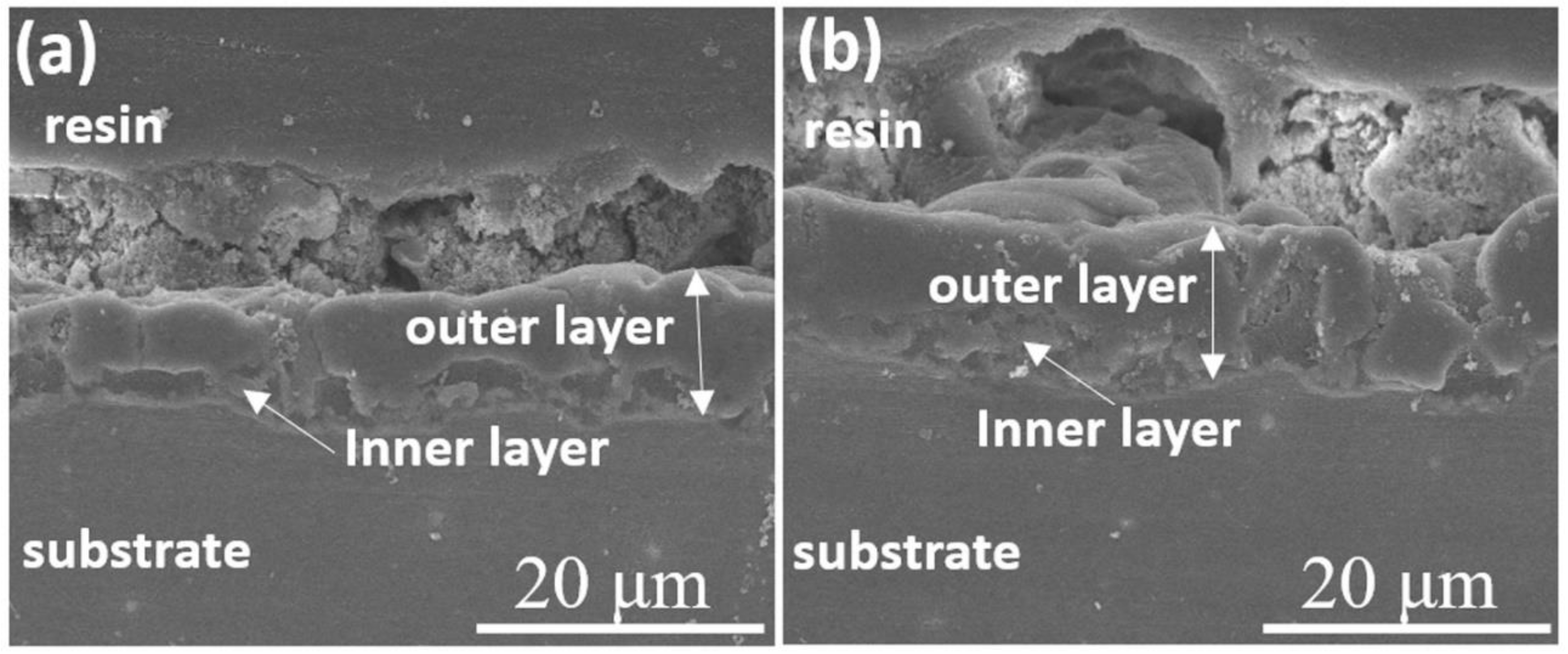
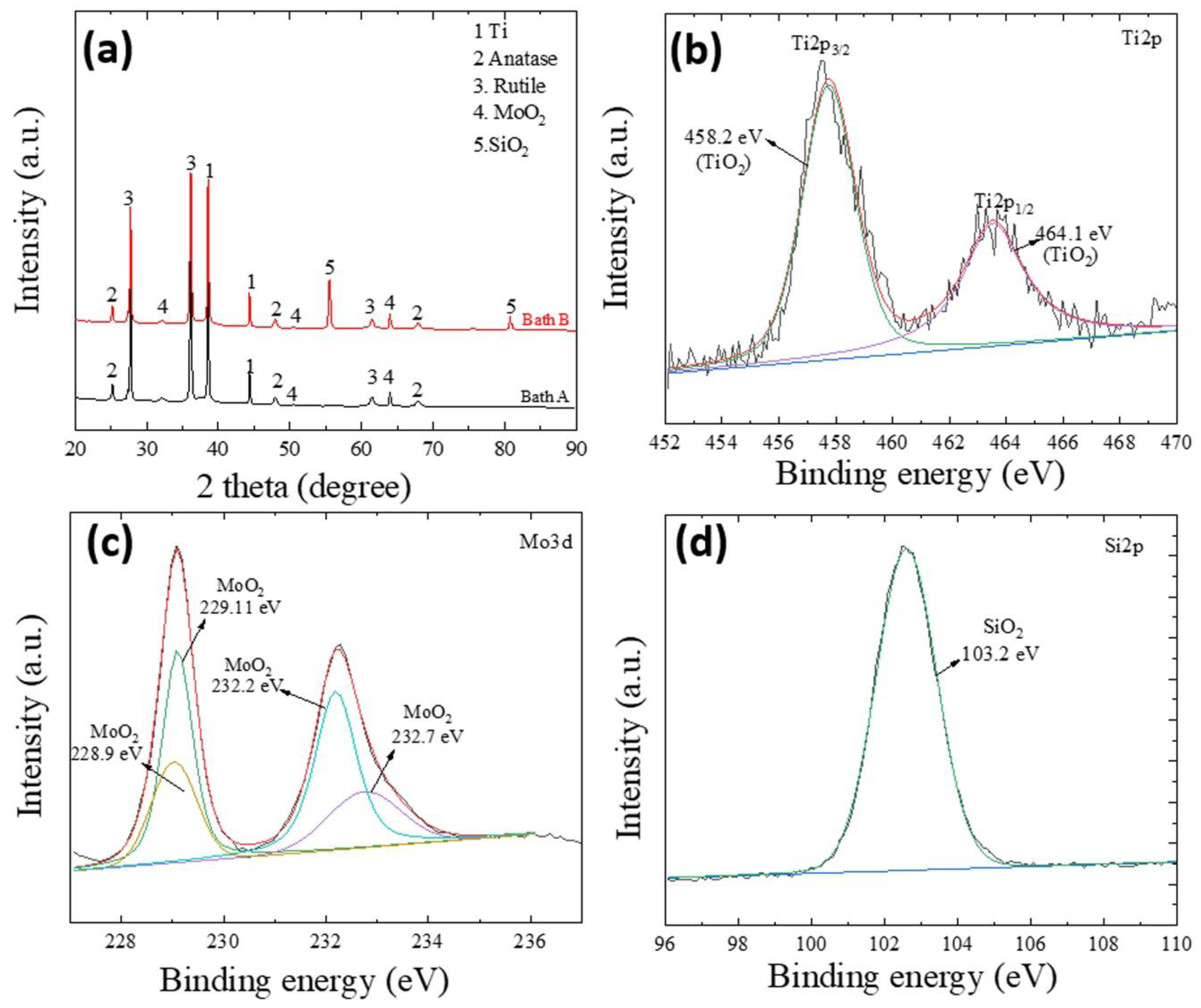
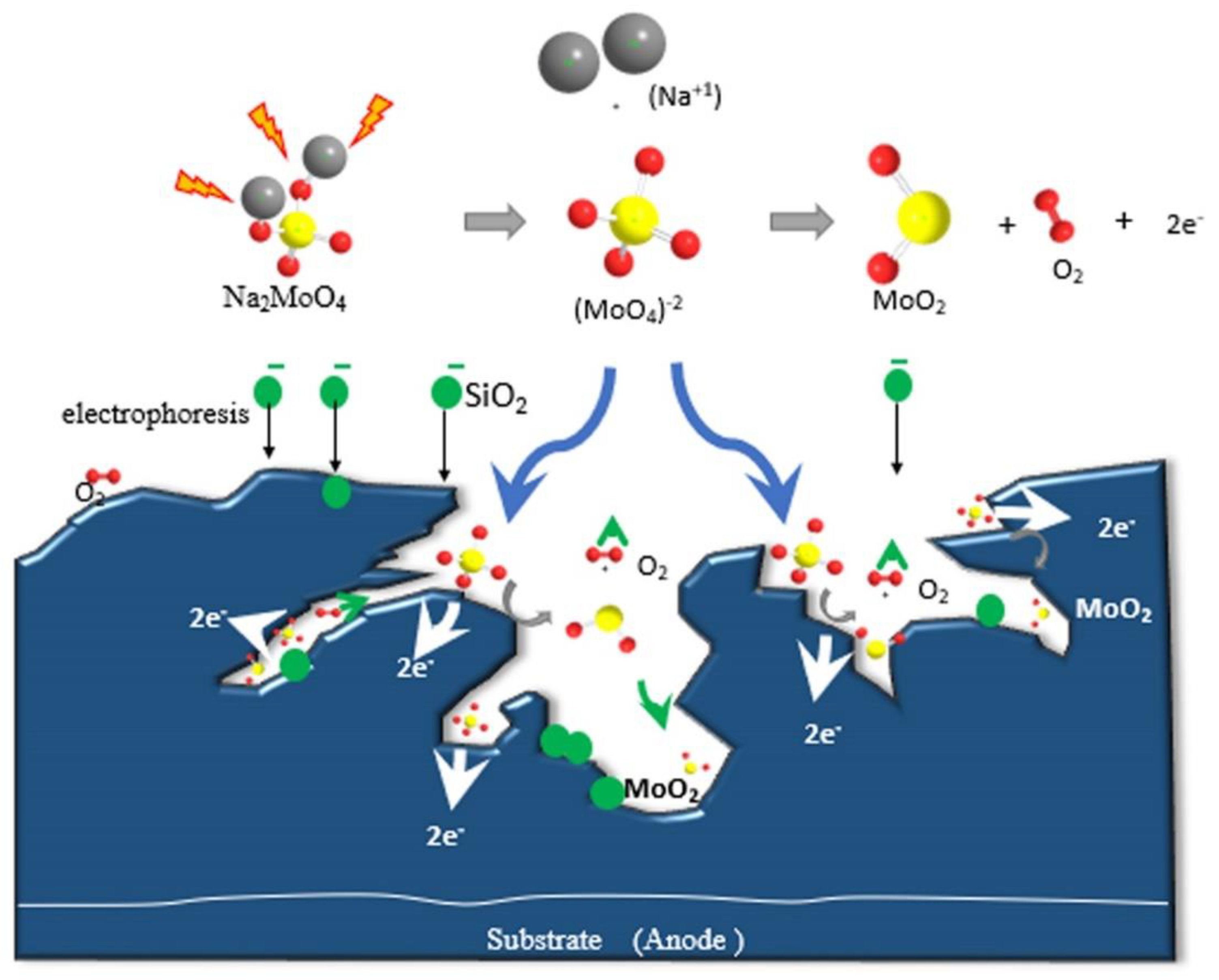

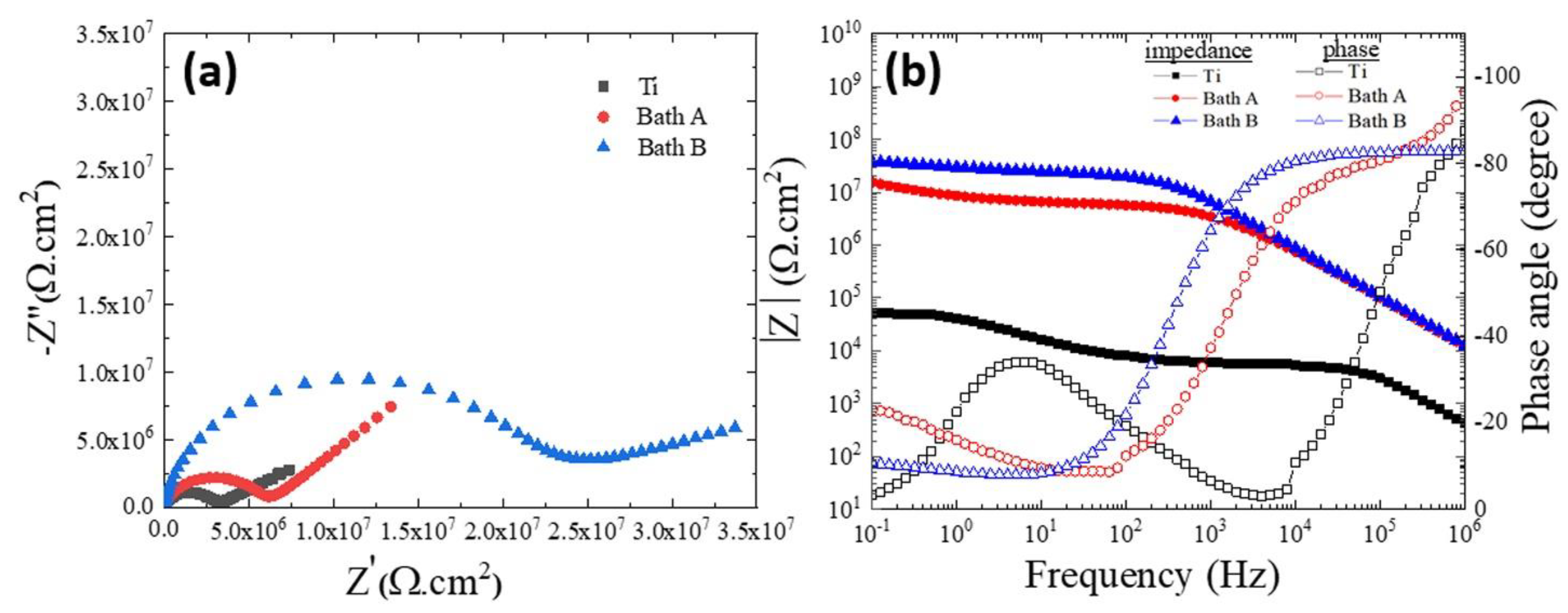
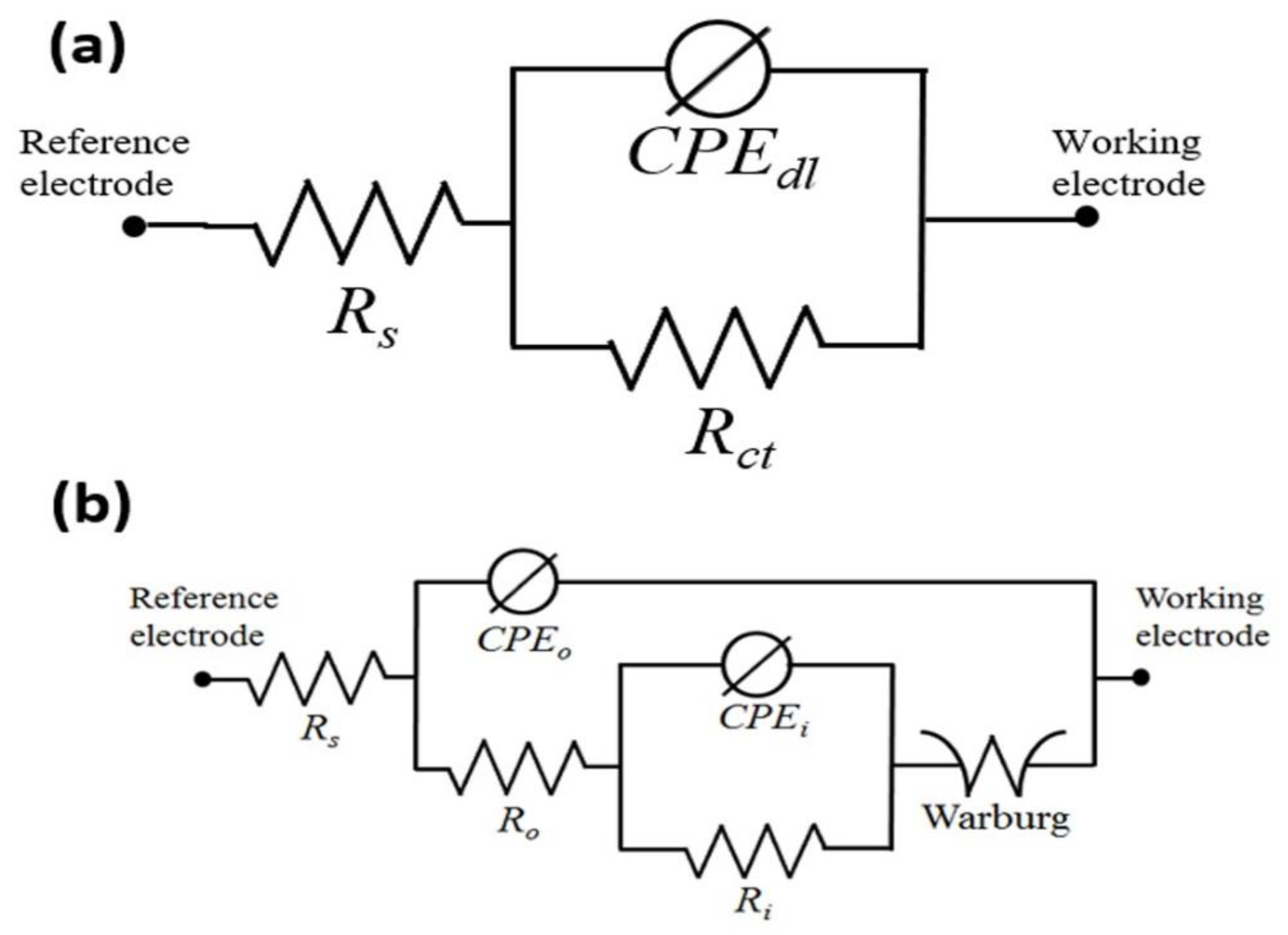
| Sample | Ecorr (V) | icorr (Acm−2) | |βc| (V/Decade) |
|---|---|---|---|
| substrate | −1.092 | 1.12 × 10−5 | 0.815 |
| Bath A | −0.933 | 2.85 × 10−6 | 0.188 |
| Bath B | −0.472 | 6.35 × 10−10 | 0.660 |
| Sample | Rs (Ω·cm2) | Ro (Ω·cm2) | CPE-no | CPE-Yo (S·sn·cm−2) | Ri (Ω·cm2) | CPE-ni | CPE-Yi (S·sn·cm−2) | W (S·S1/2) |
|---|---|---|---|---|---|---|---|---|
| Bath A | 117.2 | 7.70 × 105 | 1.00 | 1.65 ×10−11 | 5.18 × 106 | 0.58 | 4.92 × 10−8 | 1.20 × 10−7 |
| Bath B | 118.4 | 1.89 × 107 | 0.92 | 1.33 × 10−12 | 1.33 × 108 | 0.67 | 4.97 × 10−9 | 1.90 × 10−5 |
Publisher’s Note: MDPI stays neutral with regard to jurisdictional claims in published maps and institutional affiliations. |
© 2021 by the authors. Licensee MDPI, Basel, Switzerland. This article is an open access article distributed under the terms and conditions of the Creative Commons Attribution (CC BY) license (https://creativecommons.org/licenses/by/4.0/).
Share and Cite
Zehra, T.; Kaseem, M.; Hossain, S.; Ko, Y.-G. Fabrication of a Protective Hybrid Coating Composed of TiO2, MoO2, and SiO2 by Plasma Electrolytic Oxidation of Titanium. Metals 2021, 11, 1182. https://doi.org/10.3390/met11081182
Zehra T, Kaseem M, Hossain S, Ko Y-G. Fabrication of a Protective Hybrid Coating Composed of TiO2, MoO2, and SiO2 by Plasma Electrolytic Oxidation of Titanium. Metals. 2021; 11(8):1182. https://doi.org/10.3390/met11081182
Chicago/Turabian StyleZehra, Tehseen, Mosab Kaseem, Shakhawat Hossain, and Young-Gun Ko. 2021. "Fabrication of a Protective Hybrid Coating Composed of TiO2, MoO2, and SiO2 by Plasma Electrolytic Oxidation of Titanium" Metals 11, no. 8: 1182. https://doi.org/10.3390/met11081182
APA StyleZehra, T., Kaseem, M., Hossain, S., & Ko, Y.-G. (2021). Fabrication of a Protective Hybrid Coating Composed of TiO2, MoO2, and SiO2 by Plasma Electrolytic Oxidation of Titanium. Metals, 11(8), 1182. https://doi.org/10.3390/met11081182








